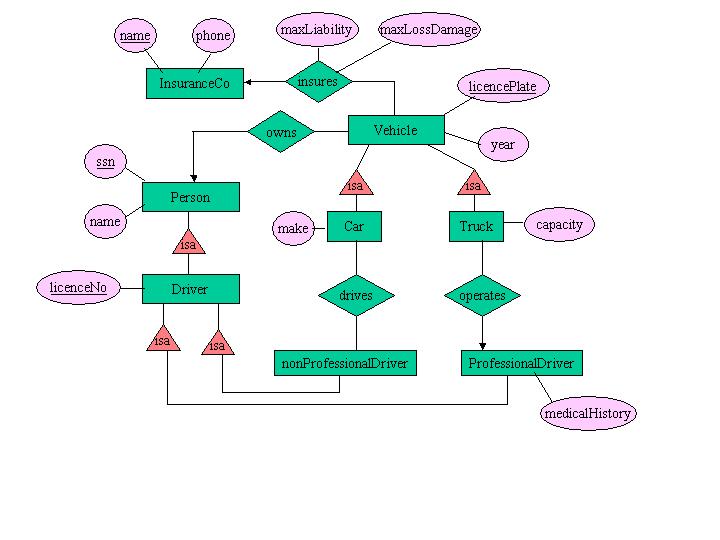- countries: name, area, population, gdp ("gross domestic product")
- cities: name, population, longitude, latitude
- rivers: name, length
- seas: name, max depths
- each city belongs to exactly one country
- each river crosses one or several countries
- each river ends in another river or in a sea
[UPDATED! 2011 Oct 11]Please indicate the keys for your entity sets, as shown in lecture.
Submit your diagram in a PNG image file called hw2-erdiagram.png. If you do not want to create a PNG, a PDF is also acceptable, but you must name it hw2-erdiagram.pdf.

- Create a relational schema that captures this E/R diagram.
Write SQL "Create Table" statements that creates the corresponding
tables. Add the necessary key, foreign key, and uniqueness constraints. Put your SQL statements in a file called
hw2-q2.sql. - Which relation in your relational schema represents the relationship "insures", in the E/R diagram and why is that your representation?
- Compare the representation of the relationships "drives" and "operates" in your schema, and explain why they are different.
Turn in your SQL statements for the first part in a file called hw2-q2.sql, submit your answers for the rest of the questions in a file called hw2-answers.txt.
- R(A,B,C,D,E) with functional dependencies D -> B, CE -> A.
- S(A,B,C,D,E) with functional dependencies A -> E, BC -> A, DE -> B.
Put your answers in hw2-answers.txt.
Consider a relation with schema R(A,B,C,D) and an unknown set of functional dependencies. For each closed attribute set below, give a set of functional dependencies that is consistent with it.
- All sets of attributes are closed.
- The only closed sets are {} and {A,B,C,D}.
- The only closed sets are {}, {A,B}, and {A,B,C,D}.
Put your answers in hw2-answers.txt.
Sales(name, discount, month, price)
His data is in this file. Once he created the table, he realized that there is something wrong with it: it was difficult to update. He hires you as a consultant to fix his data management problems. He hands you his data inand tells you: "fix it for me !". Help him by normalizing his database. Unfortunately you cannot sit down with Mr. Frumble and discuss his application to find out the functional dependencies, as you should normally do, because Mr. Frumble is simply too busy. So you have to reverse engineer the functional dependencies from his data instance. You should do the following steps:
- Create a table in postgres and import the data. For this question, turn in the create table and import statements.
- Find all functional dependencies in the database. This is a reverse engineering task, so expect to proceed in a trial and error fashion. Search first for the simple dependencies, say name -> discount then try the more complex ones, like name, discount -> month, as needed. To check each functional dependency you have to write a SQL query. Your challenge is to write this SQL query for every candidate functional dependency that you check, such that (a) the query's answer is always short (say: no more than ten lines or so), and (b) you can determine whether the FD holds or not by looking at the query's answer. Try to be clever in order not to check too many dependencies, but don't miss potential relevant dependencies. For this question, turn in all functional dependencies that you found, and for each of them the supporting SQL query that proves the existence of that functional dependency. You do not need to turn in the SQL queries that you tried but that did not turn out any functional dependency.
- Decompose the table in BCNF, and create SQL tables for the decomposed schema. Create keys and foreign keys where appropriate. For this question, turn in the SQL commands for creating the tables.
- Populate your BCNF tables from Mr. Frumble's data. For this you need to write SQL queries that load the tables you created at point iii from the table you created at point i. For this question, turn in the SQL queries that populate the normalized tables.
Submit all answers & SQL queries for this question in hw2-q5.sql. Clearly indicate which question you are answering in the comments, non-SQL statements should be commented out.